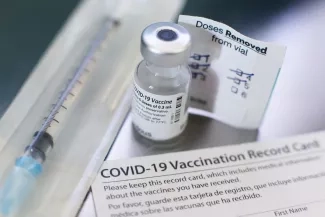Why It Matters

Photo by Justinite | Pixabay
In Spring 2020, the federally qualified health centers (FQHCs) in Northeast Ohio came together to start talking about how they were each responding to the COVID-19 pandemic. Faced with an unprecedented crisis, they wanted to pool knowledge and resources so that they could serve their patients as well as possible.
After having informal conversations for a few months, the FQHCs realized that they needed more support. They sought to establish shared goals for improving access to COVID-19 testing for communities of color and realized they could benefit from stronger coordination of strategic activities, partnerships, data-sharing, and neutral convening sessions. In Summer 2020, they approached Better Health Partnership (BHP), a multistakeholder regional health improvement collaborative that was established in 2007 to transform health care in Northeast Ohio. FQHCs are long-standing members of BHP, along with other health care providers and systems, insurance plans, social service agencies, public health, and community organizations that are committed to accelerating improvements in equitable population and community health across the region.
BHP facilitates regular meetings, every two weeks, attended by six FQHC partners who comprise the Northeast Ohio FQHC Collaborative. “They talk about what everyone’s doing related to COVID response, troubleshoot, share data and best practices,” said Kirstin Craciun, Community Impact Lead at Better Health Partnership, who leads the meetings. On alternating weeks, the FQHCs meet with representatives from local hospitals, health departments, and community partners to facilitate better communication and coordination of all COVID-related activities.
In Fall 2020, one priority was expanding access to COVID-19 testing, as well as getting the word out that testing was available to communities of color. One FQHC, The Centers (a partnership between The Centers for Families and Children and Circle Health Services, Inc.), took the lead on the project to launch a website to publicize testing availability and provide information for frequently asked questions. All FQHCs submitted information about testing sites, hours, insurance, and so on. By September, the site was live.
In December 2020, the virus surged in the region. BHP worked swiftly to connect FQHC providers with UnitedHealth Group, Greater Cleveland Congregations, and other faith-based partners to launch the Stop COVID Cleveland initiative. Their aim was to provide COVID tests and distribute food boxes and health kits in under-resourced neighborhoods. They performed a total of 3,504 COVID-19 tests and distributed 2,579 health kits and 1,953 food boxes. Of those served, 66 percent were African American. “We were really happy, especially over the holidays, to be able to provide free testing and help stop the spread of the virus,” said Craciun.
In early 2021, when the COVID-19 vaccine became available, local data showed that higher-income, white populations initially had far more access to it than lower-income populations and communities of color. BHP conveyed to the state that FQHCs needed to receive more vaccines to ensure equitable distribution. “We were successful in securing additional vaccines, using early data reflecting FQHC success in reaching communities of color,” said Craciun.
Once they received the COVID-19 vaccines, FQHCs used neighborhood-level data and work with the faith-based community to guide their distribution strategies. They held pop-up vaccination events, including one in February at Elizabeth Baptist Church on Cleveland’s East Side, where 253 people were vaccinated, 92 percent of whom were African American. At another event that same month, at La Sagrada Familia church on Cleveland’s West Side, 173 individuals received shots, 87 percent of whom were Hispanic.
These events “really showcased the role of the FQHCs in reaching our communities,” said Craciun. BHP data showed the FQHCs achieving vaccination rates for communities of color at a pace that far exceeded other vaccine providers throughout Cuyahoga County.
The FQHCs continue providing vaccinations in a wide range of community settings in addition to churches — schools, low-income housing facilities, senior housing, community festivals, city halls, and libraries — as well as onsite at their clinics. They strive to understand the challenges and concerns of the populations they serve. At the weekly meetings, they discuss what FQHC clinicians are hearing in terms of COVID-19 vaccine hesitancy, as well as approaches that have been helpful in increasing vaccine rates.
To guide their COVID-19 response, the FQHCs look to data on vaccination rates throughout the region that is provided on BHP’s website. BHP has created a valuable resource from a variety of public health data sources, indicating the percentage of residents in a given neighborhood who are vaccinated as well as the social vulnerability index of that neighborhood. “We still have some census tracts that have really low vaccination rates,” said Craciun. “Without looking at the data, we don’t know how well we’re doing and where there are opportunities to improve vaccine uptake.”
During this pandemic crisis, the importance of FQHCs has become clear. “They play such a critical role in ensuring equitable access for communities of color,” said Craciun. She is proud of the work the collaboration has accomplished: “People share best practices but are also authentic and share things that aren’t going well.”
In terms of next steps, they are working on improving integration of the FQHCs into the region’s health infrastructure and developing community health improvement plans that include the FQHCs. Meanwhile, the FQHCs themselves are discussing ways they can optimize their collective impact by working even more closely together as a network to deliver high-value health care to the community.
And, Craciun notes, they recently hit an impressive milestone: “One of our FQHCs just did their 25,000th COVID-19 vaccine shot.”
Editor’s note: Federally qualified health centers in Northeast Ohio and the Better Health Partnership participated in the IHI COVID-19 Rapid Learning Initiative. IHI gratefully acknowledges Pfizer, Inc., and BD (Becton, Dickinson and Company) for their generous funding support of the COVID-19 Vaccine Rapid Learning Initiative and their leadership and expertise in the drive for vaccine distribution.
You may also be interested in:
Identifying the Keys to Effective Vaccine Communication and Outreach
